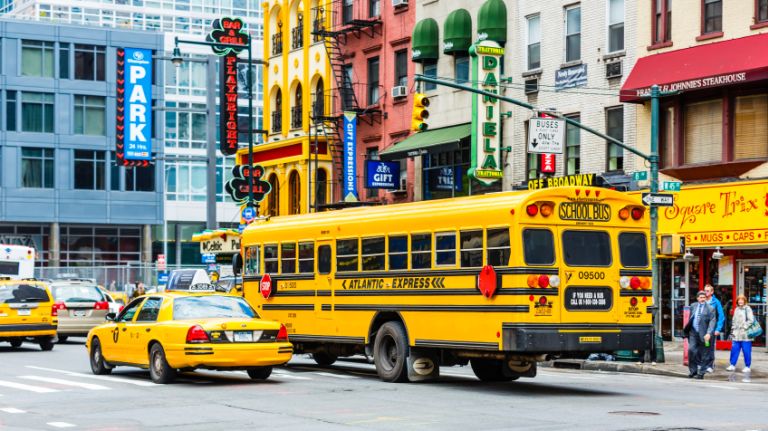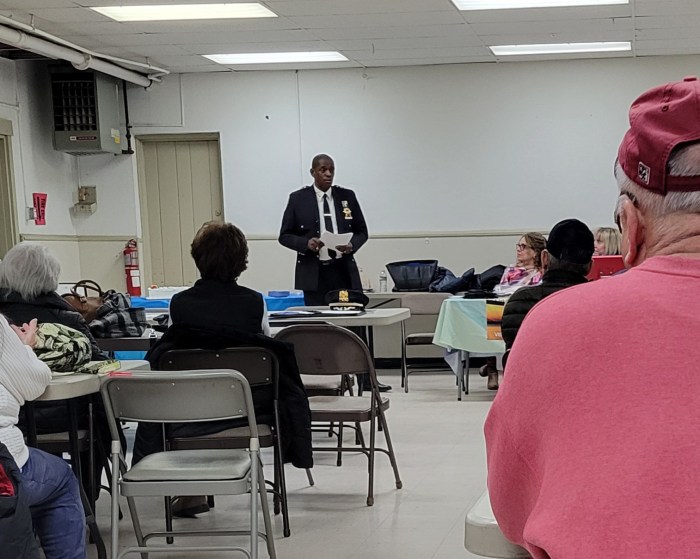A roadmap and guide to help all New York State schools transition their gas-guzzling bus fleets to electric was released by New York Governor Kathy Hochul last Friday.
The roadmap, the New York State Electric School Bus Roadmap, and the guide, The Electric School Bus Guidebook, are the state’s newest resources that provide school districts and bus operators with the technical and financial assistance required to remove vehicles that use fossil fuel from service. The roadmap and guide focus on high-need school districts.
Last April, New York became the first state in the nation to pass a school bus electrification mandate. The state has the largest school bus fleet in the country — with more than 45,000 traditional school buses that comprises 10% of the nation’s total fleet.
The release of the electric school bus roadmap and guidebook are part of the state’s requirements for all new school buses sold in New York State to be zero emission by 2027, and to have all school buses on the road be zero emission by 2035. The state is aiming to reduce greenhouse gas emissions by 85% by 2050.
Hochul stated that in an attempt to lead the way in the fight against climate change, the state must address the ways that transportation contributes to issue.
The transportation sector contributes 30% of New York State’s greenhouse gas emissions, which is roughly the same amount that transportation in New York City contributes, according to past city reports.
“Providing the tools for school districts to swap out diesel and gas school buses with zero-emission bus fleets will help students and their communities across the state breathe cleaner air and enjoy a healthier way of life,” Hochul stated.
The New York State Energy Research and Development Authority (NYSERDA) has produced both the guidebook and the roadmap.
Doreen Harris, president of the NYSERDA, stated that “our roadmap and guidebook will provide school districts and bus operators with the latest information to enhance their fleets with zero-emission buses through proper planning, purchasing, and financing.”
The New York State Electric School Bus Roadmap is an overview of the key challenges, costs, funding mechanisms, and policy options to transition all school buses in the state to a zero-emission fleet by 2035. The roadmap points to both battery-powered and hydrogen fuel cell-powered electric buses as ones that meet the definition of zero-emission buses.
Currently, only battery-powered buses are available for school districts and bus operators. The roadmap could potentially include hydrogen fuel cell-powered buses as the market develops, according to the NYSERDA.
The roadmap states that it will cost around an estimated $780 million to transition 3,000 vehicles to electric school buses by 2027. Both federal and state funding are expected to be available to support this transition, and most of these costs can be covered by federal and state funding sources, especially for high-need school districts.
The Electric School Bus Guidebook will likewise provide the benefits, costs, and challenges of transition to electric school buses, but also provide details on utilities such as bus chargers and equipment, manufacturers, and operators that school districts can use. The guidebook also details vehicle choice, procurement, and fleet planning options.
The guidebook ensures that “electric school buses can meet the bus route needs of most schools, which have an average bus route of 80 miles per day.”
The state plans to update the roadmap every three years to reflect changing zero-emission school bus market conditions, according to the announcement made on Friday. The state will add additional information to the main guidebook to cover best practices for bus routing, safety, workforce development, and technician training.
Both the roadmap and guidebook pinpoint critical factors and decisions that school districts and bus operators face when considering clean bus options. Zero-emission buses include both battery electric buses and hydrogen fuel cell buses that are expected to be available for purchase in New York State in the coming years. Both types of buses eliminate diesel and gasoline fumes that can drift into, and then linger within buses – negatively impacting air quality and child health.
A $500 million investment towards the Public School Bus Electrification Program from the Environmental Bond Act is supporting the transition to electric school bus fleets in New York State.
Those in support of the announcement include the New York School Bus Contractors Association, the New York Association for Pupil Transportation, and the World Resources Institute, and several elected officials including State Senators Kevin Parker, Shelley Mayer, and Timothy Kennedy.
Assemblymember Didi Barrett acknowledged in a statement that the roadmap and guidebook are “welcome tools” for rural school districts across the state who have expressed concerns about the challenges of electrifying their school buses.
New York Power Authority’s CEO Justin Driscoll stated that the roadmap and guide will answer many of the important questions that school districts will have as they start transitioning.
“At the Power Authority, we are preparing to assist public fleets, including school districts, in procuring and installing necessary electric bus and vehicle charging infrastructure,” Driscoll stated.
Betty Rosa, the state’s education commissioner, reiterated the need to improve the environment by reducing air pollution, especially in underserved communities where the issue disproportionately impacts its residents.
“Zero-emission school buses not only improve the environment for our students, they also promote the importance of sustainability and clean energy,” Rosa stated. “We are confident that this guide can be a helpful resource to mitigate some of the challenges associated with this worthwhile endeavor for our schools and districts across the state.”
Read more: NYPD Seeks Suspect in Bloody Coney Island Stabbing


































